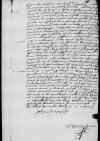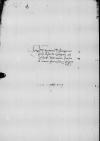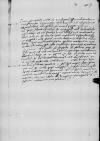List #1836
Ioannes DANTISCUS do Tiedemann GIESEHeilsberg (Lidzbark Warmiński), 1538-03-01
Regest polski:
Dantyszek wyraża dezaprobatę dla poczynań Henryka [Snellenberga]. Postrzega je jako niegodny handel i wyraża nadzieję, że Henryk powstrzyma się od „transakcji” (auctio) do czasu osobistego spotkania i rozmowy z Dantyszkiem we Fromborku (apud ecclesiam). Niepokoi go także to, co Giese powiedział mu ostatnio w Lidzbarku przy okazji wydawania przez Dantyszka zaleceń dla Achacego Trencka w sprawie szaty (vestis tabinea), jakoby ktoś obiecał Henrykowi, że Dantyszek przejmie wszystkie obietnice poprzedniego biskupa [Maurycego Ferbera]. Spodziewane spotkanie Dantyszka z Achacym Trenckiem w Gietrzwałdzie nie doszło do skutku.
Dantyszek prosi o dokładniejsze informacje w sprawie uchylania się Braniewa od płacenia akcyzy.
Podobnie jak Giese, Dantyszek czeka na [przesyłkę] z Rzymu.
Dantyszek już kilkakrotnie żądał od Rady Gdańska zaprzestania pobierania cła, ustanowionego przez nich dla handlarzy piwem. Mimo to proszą oni o utrzymanie cła do majowego sejmu [Prus Królewskich]. Dantyszek uważa tę opłatę za niedopuszczalną w odniesieniu do obu diecezji [warmińskiej i chełmińskiej]. Obawia się, że akceptacja może w przyszłości doprowadzić do nałożenia kolejnych obciążeń, toteż zachęca, by także Giese napisał do rady miasta gdańska, aby zaprzestano pobierania cła i zwrócono to, co już zostało pobrane.
Dantyszek prosi o informację o terminie, w którym adresat odebrał od Rady Gdańska trzy tysiące marek.
| odebrano 1538-03-02 Rękopiśmienne podstawy źródłowe:
Publikacje:
| ||||||
Tekst + aparat krytyczny + komentarz Zwykły tekst Tekst + komentarz Tekst + aparat krytyczny Ekscerpty dotyczące podróży Dantyszka
Reverendissimo Domino
Reverendissime Domine, frater et amice carissime et honoran(de) or honoran(dissime)⌈honoran(de)honoran(de) or honoran(dissime)⌉.
Salutem et amoris mei commendationem plurimam.
Oblitus sum superiori die de eo Dominationi Vestrae Reverendissimae cf.
Quantum autem nos eiusmodi dedecent paper damaged⌈[t]t paper damaged⌉ pacta, ne assis quidem plerique aestimant. Si animus
Remordet me et hoc, quod novissime hic mihi Dominatio Vestra Reverendissima dixit, nescio quem meo nomine
cf.
Alia in praesenti non restant, quam quod perinde atque Dominatio Vestra Reverendissima pendeo in exspectatione ex
Ex
Reverendissimae Dominationis Vestrae integerrimus frater
Postscript:
 BCz, 245, p. [1] missed in numbering after p. 8
BCz, 245, p. [1] missed in numbering after p. 8
Cum gentilibus nostris[6] de vectigali, quod[7] venditoribus et emptoribus cervisiae constituerunt, iam aliquoties cf.
De censu trium millium marcarum, quas Dominatio Vestra Reverendissima percepit, significarunt mihi, quod mox post integrum elapsum annum iuxta litteras meas eam pecuniam Dominationi Vestrae Reverendissimae numeraverint, medium vero gross(um) ratione auri hornen(sis)[8] solverunt.[9] Ut me ideo de tempore perceptionis Dominatio Vestra Reverendissima edoceat, oro plurimum etc.[10]


